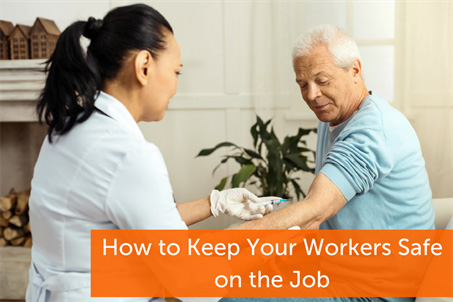As demand for home healthcare increases, so does the number of providers working in the field. While, statistically speaking, home healthcare workers are less likely to be injured on the job than those in other fields — and in fact, the likelihood of injury is higher for those working in a nursing home — there are still dangers associated with the career. As a home health agency, it’s your job to keep your team safe at work.
Understanding the Dangers
The first step to keeping your workers safe on the job is to understand the most common risks that they face. According to OSHA, there are a number of potential dangers that can be present in this field:
- Bloodborne pathogens and biological hazards, as with any healthcare-related occupation
- Ergonomic risks associated with lifting or assisting patients, or repetitive motions associated with providing patient care, documentation, etc.
- Unhygienic or unsanitary conditions in patients’ homes, which could lead to illness or infection
- Hazards within patient homes, such as clutter or debris blocking walkways, unshoveled snow, ice, etc.
- Hostile animals
- Violence, from the patient, a family member, or an unrelated party (such as a worker being assaulted when entering or leaving the home)
- Road hazards when driving to or from a patient assignment
Clearly not all these dangers are present in every assignment; not all patients have pets, for example, and many patients live in safe, clean, and well-maintained homes. However, the number of incidents of violence against home health workers is increasing; according to the National Employment Law Project, the rate of violence against home health workers has gone up 130 percent since 2005, with about half of those incidents attacks on workers by patients themselves. Given these risks, it is vital for home health agencies to provide adequate education, training, and tools to keep their workers safe.
What You Can Do
Keeping your home health team safe in the field starts with the first day of work. Your onboarding process must address job safety, and you need to have clear and effective policies regarding safety. Some of the points to address include:
How to identify and respond to threatening situations. Train your employees to evaluate their surroundings before entering a home, and to be alert to any suspicious activity or changes in behavior. Empower your employees to make decisions based on their safety, and have a procedure in place for them to report incidents and for the agency to respond and address the situation. Provide your workers with mobile devices that they can use to call for assistance when necessary.
Time management. OSHA reports that more than half of workplace injuries that require time away from work stem from overexertion. Tired employees tend to push harder than they should to get work done, and not only hurt themselves, but could also hurt patients. Using home healthcare software to schedule employees, including adequate break time, can help keep your employees safe.
Ergonomics. Train your employees in ergonomics to prevent serious injuries, including repetitive motion injuries. This training should be ongoing, as it’s easy for workers to fall into bad habits and increase the risk of injury. Encourage employees to see a health care provider if they experience symptoms of an injury.
Infection control. Proper training in infection control is important to the safety of both your workers and patients. Provide appropriate personal protective equipment, and train employees in the proper usage. Train employees in proper hand-washing techniques, and provide hand sanitizer to keep hands clean between washes. Keep work gear as sanitary as possible by carrying sanitary pads to place equipment on, rather than a surface in the home, and if a patient has an infection like MRSA, designate specific gear to leave in the home for that patient, which can be properly disinfected or disposed of after the care ends.
Home risk assessment. Before beginning care, conduct a risk assessment of the home. Take note of any pets, family members, or others living in the home. Record any potential safety issues on the patient record so that your worker is aware when he or she enters the home.
‘No Pets’ policy. Even the most ardent pet lover can be attacked or injured by a pet in a patient’s home. Some pets can become very protective of their owners, and an attack can happen in seconds. Prohibit your employees from interacting with pets; you can ask clients to put pets in a secure room or pet kennel for the duration of the visit as well.
Keeping your employees safe should be a top priority for your agency. Develop a culture of safety by regularly discussing safety issues and providing adequate, ongoing training on how your workers can protect themselves from injury. Doing so will save your agency money and productivity, by keeping your employees healthy and at work.
Want to know more about tools that can help you effectively manage your agency? Check out Complia Health’s variety of advanced home health software solutions here.




